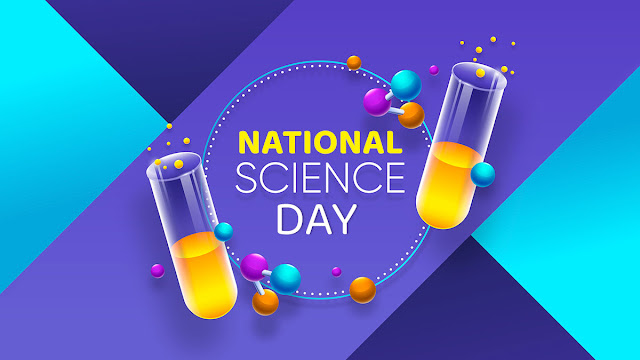NATIONAL SCIENCE DAY 2025 - 28TH FEBRUARY
ஃபிப்ரவரி 28 - தேசிய அறிவியல் தினம் 2025
TAMIL
NATIONAL SCIENCE DAY 2025 - 28TH FEBRUARY | ஃபிப்ரவரி 28 - தேசிய அறிவியல் தினம் 2025: இந்திய இயற்பியல் விஞ்ஞானியான சர் சந்திரசேகர வெங்கடராமன் (சுருக்கமாக - சர்.சி.வி.ராமன்) 'ராமன் விளைவு' என்ற கோட்பாட்டினைக் கண்டுபிடித்ததை நினைவுகூறும் விதமாக ஆண்டுதோறும் ஃபிப்ரவரி 28ஆம் நாள் 'அறிவியல் தினமாக'க் கடைப்பிடிக்கப்படுகிறது.
ராமனின் கண்டுபிடிப்புக்காக 1930ஆண்டின் நோபல் பரிசு அவருக்குக் கிடைத்தது. "ஒளி புகும் ஊடகம் ஒன்றின் வழியாக, ஒளி ஊடுருவும்போது, அந்த ஒளி சிதறடிக்கப்பட்டு, அதன் அலைநீளம் மாறுபாடு அடைக்கிறது" என்று ராமன் விளைவைச் சுருக்கமாகச் சொல்லலாம்.
இந்தத் தத்துவம் இயற்பியல் மற்றும் வேதியியலில் எண்ணற்ற வழிகளில் பயன்படுத்தப்படுகிறது. பெட்ரோலியம் மற்றும் மருந்தாக்கம் ஆகியவற்றின் உற்பத்திப் பொருட்களைக் கண்காணிப்பது, அணு உலைகளின் கழிவுகளைத் தொலைவில் இருந்தே ஆராய்வது போன்றவை 'ராமன் விளைவின்' பயன்பாட்டுக்கு உதாரணங்களாகச் சொல்லலாம்.
சி.வி. ராமனின் சொந்த ஊர் திருவானைக்காவல். இவரது தந்தை பேராசிரியராக ஒரு கல்லூரியில் பணிபுரிந்தவர். சிறுவயது முதலே ராமனுக்கு அறிவியலில் நாட்டம் அதிகம். தாயாரிடம் எப்போதும் ஏதாவது கேள்விகள் கேட்டுக்கொண்டே இருப்பார்.
அவருக்கு ஐந்து வயதாக இருக்கும்போதே, திரி விளக்குகளில் வேறு வேறு எண்ணெய்களை ஊற்றி, விளக்கின் தீபத்தில் வித்தியாசமிருக்கிறதா என்று ஆராய்வாராம்.
முகம் பார்க்கும் கண்ணாடியில் சூரிய ஒளியைப் பிரதிபலிக்கச் செய்து விளையாடுவது ராமனுக்கு மிகவும் பிடிக்கும். பத்து வயதிலேயே பள்ளிப் படிப்பை முடித்துவிட்டார். 13வது வயதில் பி.ஏ. இயற்பியல் பட்டதாரி ஆனார். அதுவும் தங்கப் பதக்கம் வென்ற முதல் மாணாக்கனாகத் தேறினார்.
அறிவியல் தினமான இன்றைய தினத்தில், தனி நபர்களுக்கும், நிறுவனங்களுக்கும் புதிய கண்டுபிடிப்புக்களுக்கான தேசிய விருதுகள் மற்றும் ரொக்கப் பணம் ஆகியன அளிக்கப்படுகின்றன.
அறிவியல் தொடர்பான கண்காட்சிகள், கருத்தரங்கங்கள் போன்றவை நாடெங்கும் நட்த்தப்படுகின்றன. பள்ளிகள், கல்லூரிகள், பல்கலைக்கழகங்கள், ஆராய்ச்சி நிறுவனங்கள் ஆகியன இந்த நாளைச் சிறப்பாகக் கொண்டாடுகின்றன.
வரலாறு
NATIONAL SCIENCE DAY 2025 - 28TH FEBRUARY | ஃபிப்ரவரி 28 - தேசிய அறிவியல் தினம் 2025: இந்திய இயற்பியலாளர் சந்திரசேகர வெங்கட ராமன் ராமன் விளைவைக் கண்டுபிடித்த நாளில் தேசிய அறிவியல் தினம் அனுசரிக்கப்படுகிறது.
ராமன் விளைவு என்பது ஒரு வெளிப்படையான பொருள் வழியாக ஒளி சிதறி, அலைநீளம் மற்றும் ஆற்றலில் மாற்றங்களுக்கு வழிவகுக்கும் நிகழ்வு ஆகும். 1928ஆம் ஆண்டு பிப்ரவரி 28ஆம் தேதி சிவி ராமன் ராமன் விளைவைக் கண்டுபிடித்தார்.
இயற்பியல் துறையில் அவரது குறிப்பிடத்தக்க பங்களிப்பிற்காக 1930 இல் இயற்பியலுக்கான நோபல் பரிசும் பெற்றார். கண்டுபிடிப்பை நினைவுகூரும் வகையில், ஒவ்வொரு ஆண்டும் பிப்ரவரி 28 அன்று தேசிய அறிவியல் தினம் அனுசரிக்கப்படுகிறது.
முக்கியத்துவம்
NATIONAL SCIENCE DAY 2025 - 28TH FEBRUARY | ஃபிப்ரவரி 28 - தேசிய அறிவியல் தினம் 2025: நமது அன்றாட வாழ்வில் அறிவியல் பயன்பாடுகளின் முக்கியத்துவம் குறித்த விழிப்புணர்வை ஏற்படுத்தவே இந்த நாள் அனுசரிக்கப்படுகிறது.
மனித நலனில் விஞ்ஞானிகளின் முயற்சிகள் மற்றும் சாதனைகளை கொண்டாடுவதும், அங்கீகரிப்பதும் இந்த நாள் நோக்கமாக உள்ளது.
தேசிய அறிவியல் தினத்தைக் கடைப்பிடிப்பதற்கான சிறந்த வழி, அறிவியல் மற்றும் தொழில்நுட்பம் முன்னேறிய விதத்தைப் புரிந்துகொள்வது மற்றும் அதிக முயற்சிகள் மேற்கொள்ள வேண்டிய இடங்களை ஆராய்வது.
தேசிய அறிவியல் தினம் 2025 கருப்பொருள்
NATIONAL SCIENCE DAY 2025 - 28TH FEBRUARY | ஃபிப்ரவரி 28 - தேசிய அறிவியல் தினம் 2025: தேசிய அறிவியல் தினம் 2025 கருப்பொருள் "விக்சித் பாரதத்திற்கான அறிவியல் மற்றும் புதுமைகளில் உலகளாவிய தலைமைத்துவத்திற்காக இந்திய இளைஞர்களை மேம்படுத்துதல்".
இந்த கருப்பொருள் இளம் மனங்களை ஊக்குவிப்பது, புதிய பங்களிப்புகளை அங்கீகரிப்பது மற்றும் இந்தியாவின் அறிவியல் சாதனைகளைக் கொண்டாடுவதில் கவனம் செலுத்தும்.
தேசிய அறிவியல் தினம் 2024 தீம்
NATIONAL SCIENCE DAY 2025 - 28TH FEBRUARY | ஃபிப்ரவரி 28 - தேசிய அறிவியல் தினம் 2025: தேசிய அறிவியல் தினம் 2024 தீம் என்பது விக்சித் பாரத்க்கான உள்நாட்டு தொழில்நுட்பங்கள்.
ENGLISH
NATIONAL SCIENCE DAY 2025 - 28TH FEBRUARY: Every year February 28th is observed as 'Science Day' to commemorate the discovery of the theory of 'Raman effect' by Indian physicist Sir Chandrasekhara Venkataraman (abbreviated as - Sir CV Raman). He received the 1930 Nobel Prize for his discovery of Raman.
The Raman effect can be summed up as "When light passes through a transparent medium, the light is scattered and its wavelength changes." This principle is used in physics and chemistry in countless ways.
Examples of applications of the 'Raman effect' include monitoring petroleum and pharmaceutical products, and remote sensing of nuclear reactor waste.
C.V. Raman's native place is Thiruvanaikaval. His father worked as a professor in a college. From childhood, Raman had a keen interest in science. He is always asking his mother some questions.
When he was five years old, he would pour different oils into wick lamps and see if there was any difference in the light of the lamp. Raman loves to play with reflecting sunlight in the face mirror.
He completed his schooling at the age of ten. B.A at the age of 13. Graduated in Physics. He also became the first student to win a gold medal. On Science Day today, individuals and organizations are given national awards and cash prizes for their innovations.
Science related exhibitions, seminars etc. are organized all over the country. Schools, colleges, universities and research institutes celebrate this day.
History
NATIONAL SCIENCE DAY 2025 - 28TH FEBRUARY: National Science Day is observed on the day Indian Physicist Chandrasekhara Venkata Raman discovered the Raman Effect. The Raman Effect is the phenomenon where light gets scattered when passed through a transparent material, leading to changes in wavelength and energy.
In 1928, on February 28, CV Raman discovered the Raman Effect. He also received the Nobel Prize in Physics in 1930 due to his significant contribution in the field of Physics. Commemorating the discovery, National Science Day is observed on February 28 every year.
Significance
NATIONAL SCIENCE DAY 2025 - 28TH FEBRUARY: The day is observed to raise awareness about the importance of scientific applications in our daily lives. The day also aims to celebrate and acknowledge the efforts and achievements of scientists in human welfare.
The best way to observe National Science Day is by understanding the way science and technology have progressed and exploring the spaces where more efforts need to be made.
National Science Day 2025 Theme
NATIONAL SCIENCE DAY 2025 - 28TH FEBRUARY: National Science Day 2025 Theme is “Empowering Indian Youth for Global Leadership in Science & innovation for Viksit Bharat”.
This theme will focus on encouraging young minds, recognizing groundbreaking contributions, and celebrating India's scientific achievements.
National Science Day 2024 Theme
NATIONAL SCIENCE DAY 2025 - 28TH FEBRUARY: National Science Day 2024 Theme is Indigenous Technologies for Viksit Bharat.








0 Comments